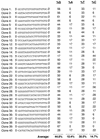The preference for GT-rich DNA by the yeast Rad51 protein defines a set of universal pairing sequences
- PMID: 9407034
- PMCID: PMC316816
- DOI: 10.1101/gad.11.24.3423
The preference for GT-rich DNA by the yeast Rad51 protein defines a set of universal pairing sequences
Abstract
The Rad51 protein of Saccharomyces cerevisiae is a eukaryotic homolog of the RecA protein, the prototypic DNA strand-exchange protein of Escherichia coli. RAD51 gene function is required for efficient genetic recombination and for DNA double-strand break repair. Recently, we demonstrated that RecA protein has a preferential affinity for GT-rich DNA sequences-several of which exhibit enhanced RecA protein-promoted homologous pairing activity. The fundamental similarity between the RecA and Rad51 proteins suggests that Rad51 might display an analogous bias. Using in vitro selection, here we show that the yeast Rad51 protein shares the same preference for GT-rich sequences as its prokaryotic counterpart. This bias is also manifest as an increased ability of Rad51 protein to promote the invasion of supercoiled DNA by homologous GT-rich single-stranded DNA, an activity not previously described for the eukaryotic pairing protein. We propose that the preferred utilization of GT-rich sequences is a conserved feature among all homologs of RecA protein, and that GT-rich regions are loci for increased genetic exchange in both prokaryotes and eukaryotes.
Figures



Similar articles
-
DNA RECOMBINATION. Base triplet stepping by the Rad51/RecA family of recombinases.Science. 2015 Aug 28;349(6251):977-81. doi: 10.1126/science.aab2666. Science. 2015. PMID: 26315438 Free PMC article.
-
In vitro selection of preferred DNA pairing sequences by the Escherichia coli RecA protein.Genes Dev. 1996 Aug 1;10(15):1890-903. doi: 10.1101/gad.10.15.1890. Genes Dev. 1996. PMID: 8756347
-
Base pair switching by interconversion of sugar puckers in DNA extended by proteins of RecA-family: a model for homology search in homologous genetic recombination.Proc Natl Acad Sci U S A. 1998 Sep 15;95(19):11071-6. doi: 10.1073/pnas.95.19.11071. Proc Natl Acad Sci U S A. 1998. PMID: 9736691 Free PMC article.
-
Homologous genetic recombination as an intrinsic dynamic property of a DNA structure induced by RecA/Rad51-family proteins: a possible advantage of DNA over RNA as genomic material.Proc Natl Acad Sci U S A. 2001 Jul 17;98(15):8425-32. doi: 10.1073/pnas.111005198. Proc Natl Acad Sci U S A. 2001. PMID: 11459985 Free PMC article. Review.
-
Double-strand break repair: are Rad51/RecA--DNA joints barriers to DNA replication?Trends Genet. 2001 Jun;17(6):318-21. doi: 10.1016/s0168-9525(01)02309-5. Trends Genet. 2001. PMID: 11377793 Review.
Cited by
-
Characterization of a mouse recombination hot spot locus encoding a novel non-protein-coding RNA.Mol Cell Biol. 2004 Jun;24(12):5620-34. doi: 10.1128/MCB.24.12.5620-5634.2004. Mol Cell Biol. 2004. PMID: 15169920 Free PMC article.
-
Homologous recombination occurs frequently at innate GT microsatellites in normal somatic and germ cells in vivo.BMC Genomics. 2018 May 11;19(1):359. doi: 10.1186/s12864-018-4758-y. BMC Genomics. 2018. PMID: 29751739 Free PMC article.
-
Yeast cell-free system that catalyses joint-molecule formation in a Rad51p- and Rad52p-dependent fashion.Biochem J. 2000 Apr 15;347(Pt 2):363-8. doi: 10.1042/0264-6021:3470363. Biochem J. 2000. PMID: 10749664 Free PMC article.
-
Probing the DNA sequence specificity of Escherichia coli RECA protein.Nucleic Acids Res. 2006 May 9;34(8):2463-71. doi: 10.1093/nar/gkl302. Print 2006. Nucleic Acids Res. 2006. PMID: 16684994 Free PMC article.
-
TRF1 and TRF2 differentially modulate Rad51-mediated telomeric and nontelomeric displacement loop formation in vitro.Biochemistry. 2014 Sep 2;53(34):5485-95. doi: 10.1021/bi5006249. Epub 2014 Aug 21. Biochemistry. 2014. PMID: 25115914 Free PMC article.
References
-
- Altschul SF, Gish W, Miller W, Myers EW, Lipman DJ. Basic local alignment search tool. J Mol Biol. 1990;215:403–410. - PubMed
-
- Anderson DG, Kowalczykowski SC. The translocating RecBCD enzyme stimulates recombination by directing RecA protein onto ssDNA in a χ-regulated manner. Cell. 1997;90:77–86. - PubMed
-
- Ashley T, Ward DC. A “hot spot” of recombination coincides with an interstitial telomeric sequence in the Armenian hamster. Cytogenet Cell Genet. 1993;62:169–171. - PubMed
-
- Ashley T, Cacheiro NL, Russell LB, Ward DC. Molecular characterization of a pericentric inversion in mouse chromosome 8 implicates telomeres as promoters of meiotic recombination. Chromosoma. 1993;102:112–120. - PubMed
Publication types
MeSH terms
Substances
Grants and funding
LinkOut - more resources
Full Text Sources
Molecular Biology Databases
Research Materials
Miscellaneous
